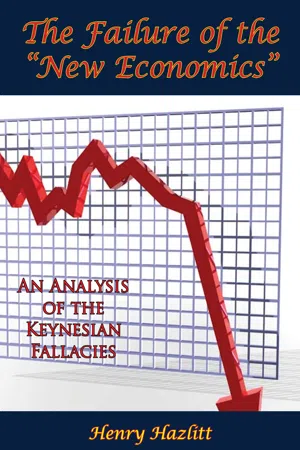Economics
Savings Investment Identity
The Savings Investment Identity is an economic concept that states that total savings in an economy must equal total investment. In other words, the amount of money saved by individuals and businesses must be equal to the amount of money invested in capital goods and structures. This identity is a key principle in understanding the relationship between savings and investment in an economy.
Written by Perlego with AI-assistance
Related key terms
Related key terms
1 of 4
Related key terms
1 of 3
4 Key excerpts on "Savings Investment Identity"
- eBook - ePub
- Lorenzo Garbo, Dorene Isenberg, Nicholas Reksten(Authors)
- 2020(Publication Date)
- Routledge(Publisher)
INCOME C + I = C + S (5.2) where S indicates “savings.” When the economy is in equilibrium (consumption goods and services purchased equals to consumption goods and services produced), this identity implies the following equality: S = I : National Savings equals Investments : this is the macroeconomic equilibrium condition of a closed economy without public sector. Note : The terms savings and investment may be confusing, as lay people tend to use them interchangeably. In macroeconomics, investments have a very precise and distinctive meaning: investments are only the purchases of new capital goods, such as equipment and buildings, by firms. In the language of macroeconomics, if you say that someone “invests in a treasury bond,” this someone does not actually invest : they save. Case b: One degree more realistic – closed economy with public sector FIGURE 5.2 Flow diagram of closed economy with public sector The fundamental identity in this case is: TOTAL EXPENDITURES ON PRODUCTION = TOTAL ALLOCATION OF INCOME C + G + I = C + S P r i v a t e + T (5.3) where T indicates Taxes, G indicates Government expenditure, and S Private indicates savings by households. The macroeconomic equilibrium condition of a closed economy with a public sector then is given. by: S P r i v a t e − I = G − T (5.4) Recall also that if T > G, then the government is running a budget surplus, and this surplus is equal to “public savings.” So, the equilibrium condition can be also written. as: S P r i v a t e + (T − G) = S P r i v a t e + S P u b l i c = I (5.5) Opportunities for further reflection Notice that: if S Private > I, then the economy must be running a budget deficit (G > T) - Henry Hazlitt(Author)
- 2016(Publication Date)
- Golden Springs Publishing(Publisher)
Saving and Investment have been so defined that they are necessarily equal in amount, being, for the community as a whole, merely different aspects of the same thing” (p. 74). But before he gets to this admission of identity, he has already made and expanded upon his contention of equality:“Income = value of output = consumption + investment. “Saving = income-consumption. “Therefore saving = investment (p. 63).” Now if, following the symbols used by the Keynesians, we let income be called Y, consumption C, investment I, and saving S, we arrive at the famous formulas: Y=I+C. S=Y–C. Therefore: I=S.“Whilst, therefore, the amount of saving is an outcome of the collective behavior of individual consumers and the amount of investment of the collective behavior of individual entrepreneurs, these two amounts are necessarily equal, since each of them is equal to the excess of income over consumption....Provided it is agreed that income is equal to the value of current output, that current investment is equal to the value of that part of current output which is not consumed, and that saving is equal to the excess of income over consumption...the equality of saving and investment necessarily follows. In short—All this is undeniable—provided we define these terms and symbols as Keynes in this chapter defines them. We cannot say that this use of these terms, or that these definitions, are wrong . If Keynes, in fact, had explicitly defined both “saving” and “investment” as meaning simply unconsumed output (which he never did do) then not only the equality but the identity of “saving” and “investment” would have been obvious.But while, to repeat, no usage or definition of words can be arbitrarily dismissed as “wrong,” we may properly ask some questions of it. Is it in accordance with common usage? Or does it depart so much from common usage as to cause confusion—in the mind of the reader, or of the user himself? Does it help, or hinder, study of the problems involved? Is it precise, or vague? And finally, is it used or applied consistently?- Yusuke Horiguchi(Author)
- 1992(Publication Date)
- INTERNATIONAL MONETARY FUND(Publisher)
In order to develop the framework, some simple equations need to be presented. First, the net national saving rate may be viewed in terms of the uses of saving from a flow-of-funds vantage point. whereNS = net national savingIF = net fixed investmentIV = inventory investmentNFS = net foreign saving51NY = net national productand all variables are in nominal terms.The identity (1) states that net national saving plus any inflow of foreign saving equals domestic investment (fixed plus inventories). At the same time, the share of net fixed investment equals the product of the growth in the net capital stock, the capital-output ratio, and the relative price of capital goods. That is,where= growth of the real net capital stockK = level of the net capital stockY = real net national productPk = deflator for net fixed investmentPy = deflator for net national product.A third useful identity is that the growth in the capital stock is the sum of growth in employment and growth in the amount of capital per worker. That is, where= total employment, with other notation as before.The fourth equation in the system is a production function, assumed to be of Cobb-Douglas form.From the production function, one can derive that the rate of growth of productive potential equals the sum of multifactor productivity growth plus the growth of the labor force weighted by its share of output (1–α) and the growth rate of capital weighted by its share (α). That is,Given these equations and some other assumptions, it is possible to solve for the path of the capital stock, net investment, and net national savings over a projection period. The important assumptions relate to the following variables:- eBook - ePub
Introducing a New Economics
Pluralist, Sustainable and Progressive
- Jack Reardon, Maria Alejandra Caporale Madi, Molly Scott Cato(Authors)
- 2017(Publication Date)
- Pluto Press(Publisher)
13
Consumption, Investment and Savings
Given the central role of consumption in contemporary global capitalism, this chapter explores the economic concepts of consumption, investment and savings, while explaining how finance currently dominates decisions about consumption and investment. To understand the contemporary challenges to sustainable investment, the recent history of private investment and the flow of finance between countries will also be analysed. Our discussion will draw on the contributions of John Maynard Keynes and Michał Kalecki. Both articulated a different view of the relationship between finance and economic development from neoclassical economists; each emphasised the importance of ‘effective demand’ to understand the dynamics of the capitalist system.13.1 HOUSEHOLD CONSUMPTION
As we have seen previously, livelihoods, work and consumption are central to understanding economics as the provisioning of human needs. In contemporary capitalism, and especially in the United States, consumption is the engine of economic growth, comprising approximately 70 per cent of US GDP. As the scale of consumption increases, the sheer volume of production of material goods pressures the ecosystems on which we depend. So while ecological sustainability requires us to recognise the existence of biophysical limits, the need to keep aggregate demand (i.e. the sum total of a nation’s demand for goods and services made by consumers, firms, government at all levels, and foreigners) at sufficiently high levels means that we have to maintain current consumption: in other words, if we do not follow a path of increasing consumption we will condemn the economy to recession. From another angle, consumption is no longer just about meeting our everyday needs but establishes our identity and becomes a substitute for face-to-face human relationships.
Index pages curate the most relevant extracts from our library of academic textbooks. They’ve been created using an in-house natural language model (NLM), each adding context and meaning to key research topics.
Explore more topic indexes
Explore more topic indexes
1 of 6
Explore more topic indexes
1 of 4



